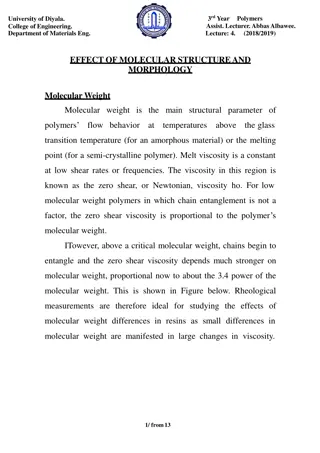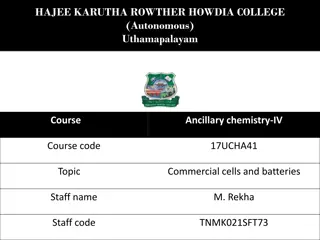Understanding the Molecular Composition of Living Cells
Living cells are primarily composed of hydrogen, oxygen, nitrogen, carbon, phosphorus, and sulfur, which form the basis of organic biomolecules. Cells have common features such as cytoplasm, cell membranes, and nuclei. Different types of cells exist, ranging from eukaryotic with organized nuclei to prokaryotic lacking a discrete nucleus. Macromolecules like proteins, nucleic acids, polysaccharides, and lipids are essential components of cell structure and function. Through polymerization, smaller building blocks combine to form complex molecules vital for life processes.
Download Presentation

Please find below an Image/Link to download the presentation.
The content on the website is provided AS IS for your information and personal use only. It may not be sold, licensed, or shared on other websites without obtaining consent from the author. Download presentation by click this link. If you encounter any issues during the download, it is possible that the publisher has removed the file from their server.
E N D
Presentation Transcript
The Molecular composition of living cells All living organisms, from microbes to mammals, are composed of chemical substances from both the inorganic and organic world, that appear in roughly the same proportions, and perform the same general tasks. Hydrogen, oxygen, nitrogen, carbon, phosphorus, and sulfur normally make up more than 99% of the mass of living cells, and when combined in various ways, form virtually all known organic biomolecules. They are initially utilized in the synthesis of a small number of building blocks that are, in turn, used in the construction of a vast array of vital macromolecules (figure 1). The cell is the unit of life. Cells in multicellular organisms function in association with other specialized cells, but many organisms are free-living single cells. Although differing in size, shape, and functions, there are basic common features in all cells. Every cell contains cytoplasm, a colloidal system of large biochemical in a complex solution of smaller organic molecules and inorganic salts. The cytoplasm is bounded by a semi elastic, selectively permeable cell membrane that controls the transport of molecules into and out of the cell. There are biochemical transport mechanisms that spend energy to bring substances into the cell despite unfavorable concentration gradients across the membrane.
Cells are protected by rigid cell walls external to the cell membranes. In most cells, the chromosomes are surrounded by a membrane to form a conspicuous nucleus. Cells with organized nuclei are described as eukaryotic. Other intracellular structures serve as specialized sites for cellular activities. For example, photosynthesis is carried out by organelles called chloroplasts. In bacteria and cyanobacteria (formerly called blue-green algae), the chromosomes are not surrounded by a membrane, and there is little apparent subcellular organization. Lacking a discrete nucleus, these organisms are said to be prokaryotic. Microorganisms of special concern to biochemical engineering include yeasts, bacteria, algae, and molds. The protozoa can feed on smaller organisms in natural waters and in waste-treatment processes but are not useful in producing materials of commercial value. Certain viruses called phages are also important in that they can infect microorganisms and may destroy a culture. A beneficial feature of microbial viruses is the ability to convey genetic materials from other sources into an organism. This is called transduction.
A macromolecule is a very large molecule, such as protein, commonly created by the polymerization of smaller subunits (monomers). They are typically composed of thousands of atoms or more. There are four general classes of macromolecules within living cells: nucleic acids, proteins, polysaccharides, and lipids. Synthetic macromolecules include common plastics and synthetic fibers as well as experimental materials such as carbon nanotubes.
These compounds, which have molecular weights ranging from 1 x 103 to 1 x 106, are created through polymerization of building blocks that have molecular weights in the range of 50 to 150. Although subtle differences do exist between cells (e.g., erythrocyte, liver, muscle or fat cell), they all generally contain a greater variety of proteins than any other type of macromolecule, with about 50% of the solid matter of the cell being protein (15% on a wet weight basis). Cells generally contain many more protein molecules than DNA molecules, yet DNA is typically the largest biomolecule in the cell. About 99% of cellular molecules are water molecules, with water normally accounting for approximately 70% of the total wet-weight of the cell. Although water is obviously important to the vitality of all living cells, the bulk of our attention is usually focused on the other 1% of biomolecules.
Composition, Structure and Function of Biomolecules The molecules found in the organisms are called biomolecules and they obey the same laws of physics and chemistry. Biomolecules are molecules that occur naturally in living organisms. Biomolecules include macromolecules like proteins, carbohydrates, lipids and nucleic acids. It also includes small molecules like primary and secondary metabolites and natural products. Biomolecules consists mainly of carbon and hydrogen with nitrogen, oxygen, sulphur, and phosphorus. Biomolecules are very large molecules of many atoms that are covalently bound together. Most, but not all, of the carbon-containing molecules in cells are built up from members of one of four different families of small organic molecules: sugars, amino acids, nucleotides, and fatty acids. Each of these families contains a group of molecules that resemble one another in both structure and function. In addition to other important functions, these molecules are used to build large macromolecules. For example, the sugars can be linked to form polysaccharides such as starch and glycogen, the amino acids can be linked to form proteins, the nucleotides can be linked to form the DNA (deoxyribonucleic acid) and RNA (ribonucleic acid) of chromosomes, and the fatty acids can be linked to form the lipids of all cell membranes.
All forms of life are composed of biomolecules only. Biomolecules are organic molecules especially macromolecules like carbohydrates, proteins in living organisms. All living forms bacteria, algae, plant and animals are made of similar macromolecules that are responsible for life. All the carbon compounds we get from living tissues can be called biomolecules.
Cell membrane The cell membrane (also known as the plasma membrane or cytoplasmic membrane, and historically referred to as the plasma lemma) is a biological membrane that separates the interior of all cells from the outside environment (the extracellular space). It consists of a lipid bilayer with embedded proteins. The basic function of the cell membrane is to protect the cell from its surroundings. The cell membrane controls the movement of substances in and out of cells and organelles. In this way, it is selectively permeable to ions and organic molecules.























